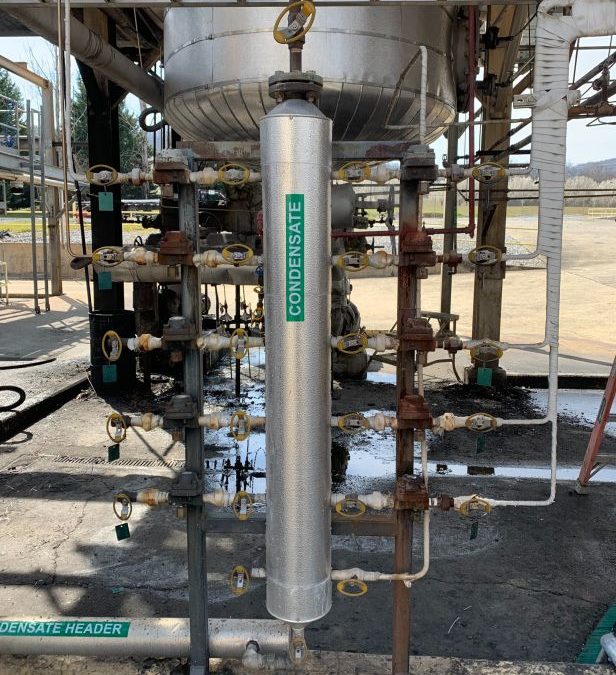Just about every industrial facility has a steam system. The purpose of that system is to move heat from one place to another. Water starts in the boiler, then is heated and transforms into steam.
That steam puts raw energy to work. It can hold a lot of energy, travels well through tubing, and can transfer heat uniformly. But it does sweat.
This “sweat” is condensate, which forms when steam releases energy through work and transforms back into water. It creates issues for the steam system’s function, causing inefficiencies, and therefore must be removed. The solution? Steam traps.
Contact PALA for Expert Steam System Optimization
Need help testing and optimizing your steam trap and system? PALA can help. We partner with Moody Price and TLV to utilize TLV’s Steam System Optimization System — an innovative program that helps eliminate inefficiencies and run your facility at peak performance.
To learn more about working with us, call us at (225) 226-7400 or contact us online.
What Is a Steam Trap?
A steam trap is a device that removes condensate and incondensable gas from a facility’s steam system, without leaking steam. It’s an automatic valve that opens, closes, and regulates autonomously.
Steam traps are just one component of a facility’s larger steam system. A full steam system will have many steam traps. They are usually placed at these locations:
- Every 50-150 feet of straight pipe
- After every heat exchanger
- At every place where there’s an elevation or pressure change
How Does a Steam Trap Work?
Generally speaking, steam traps work by keeping steam in the system’s “steam loop” while extracting air and condensate and redirecting it to the “condensate loop.” The condensate loop then feeds into a tank where the substance is either processed and returned to the boiler or cooled and disposed of as waste.
While this is the general process, it can vary depending on the type of steam trap used.
3 Main Types of Steam Traps
There are three main categories that different types of steam traps fall under: mechanical, thermodynamic, and thermostatic.
1. Mechanical Steam Traps
Mechanical steam traps include ball float steam traps, lever float steam traps, and inverted bucket steam traps. They function by using the difference in density between steam and condensate. For this reason, they’re also commonly called “density traps.”
2. Thermodynamic Steam Traps
Thermodynamic steam traps include disc steam traps, impulse steam traps, and labyrinth steam traps. They operate by using changes in kinetic energy between high-velocity steam (gas) and slower-moving condensate (liquid).
3. Thermostatic Steam Traps
Thermostatic steam traps include bi-metal steam traps, balanced pressure steam traps, and expansion thermostatic steam traps. They function by using the difference in temperature between condensate close to steam temperature and sub-cooled condensate.
Each of these steam trap types is ideally suited for certain applications. There are no “right” or “wrong” choices here — just choices that are better or worse for your specific use. It’s best to talk to a steam system specialist to determine which type would work best for your facility.
Why Are Steam Traps Necessary?
Steam traps are a critical part of any facility’s steam system. Without them, condensate and incondensable gasses couldn’t be released from the system safely — causing the system to lose efficiency and the facility to waste money on added energy costs. Here’s why.
Steam transfers heat much better than liquid condensate, so there’s no need for that condensate to be in the system. If condensate stays in the system, then more energy is needed for it to function. Plus, the condensate cools down the steam, so if they’re both in the system, it’s a waste of energy to reheat the steam that was already hot enough.
Therefore, steam traps are necessary to get that condensate out and keep the steam in.
The Importance of Steam Trap Inspection & Maintenance
Installing steam traps is the first step to steam system success. The second step is inspecting and maintaining them regularly. Like any mechanical device, steam traps risk experiencing everyday wear and tear. Since a facility’s steam system affects its overall energy usage, it’s important to ensure all traps are functioning properly at all times.
Here’s the general rule for steam trap preventative maintenance: the higher the steam trap pressure, the more frequent the inspection, testing, and maintenance. It’s common for facilities to test their steam traps every three-six months, but that timeline could vary depending on trap pressure.
During inspections, tests, and maintenance, important things to look out for include:
- Reduced product quality
- Unscheduled shutdowns
- Equipment trips and failures
- Heating bottlenecks
- Slippery work areas
- Poor condensate management
If a steam system suffers from any of those issues, it could result in serious economic losses for the facility. For example, based on 350,000 facilities surveyed for benchmark data and a CO2 conversion factor of 0.146 lb-CO2/lb steam, you can expect:
- 1,500 lb/year average steam loss for every 100 steam traps
- 24% average failure (9% blocked, 15% leaking) — the goal for this should be no more than 3%!
- Increased lifecycle costs due to failing trap stations
- 220,000 lb/year of CO2 emissions for every 100 steam traps
Needless to say, if you’re not already inspecting and testing your steam system and traps for inefficiencies, you need to. You could be wasting thousands of dollars per year.

